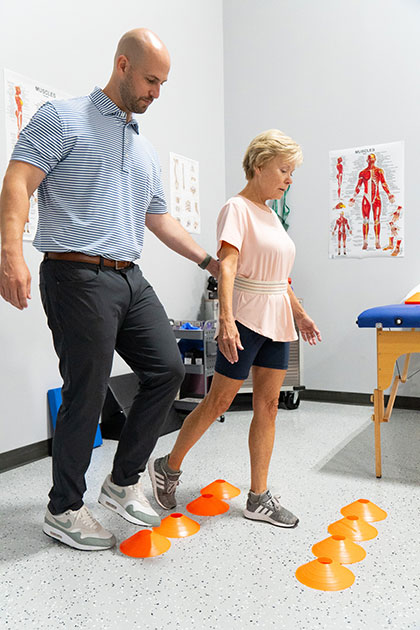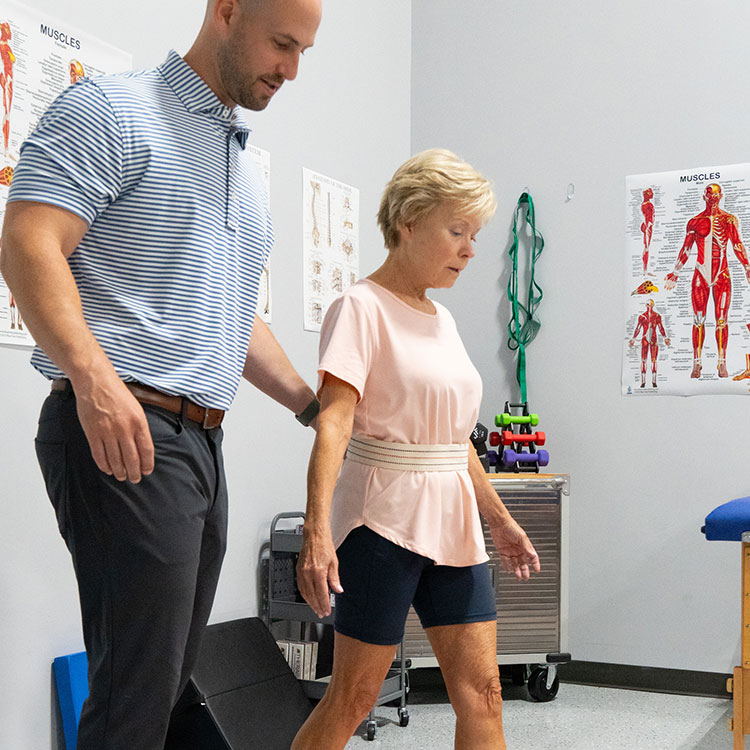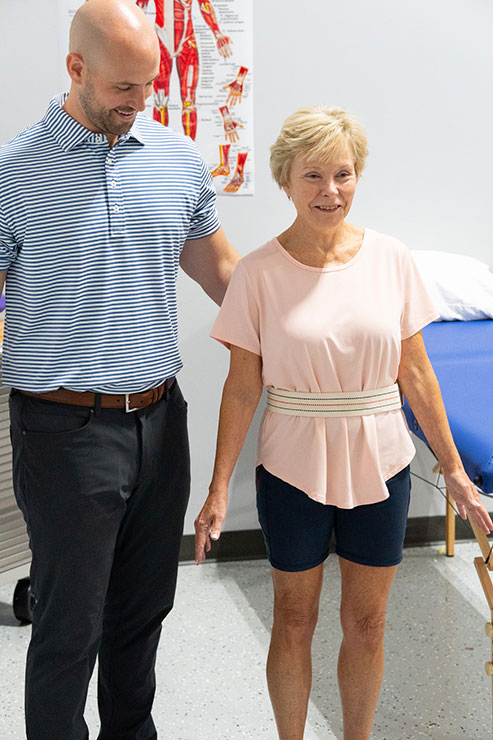Lower Back Pain Therapists in North Charlotte
Low back pain is the most common of all the orthopedic conditions we treat. Most people will have at least one episode of lower back pain in their lifetime, but do not accept the idea that you should deal with your pain because you know it happens to numerous people!
Your lower back pain may be short-lived and occur every few months, or it may be more of a chronic issue. It can be related to too much or too little activity, an accident, or you may not know why you are hurting. Lower back pain comes in many different shapes and sizes. We never want a patient to feel defeated by their lower back pain. We want them to know they can overcome it! Understanding your individual needs helps our patient-centered approach.
What is Lower Back Pain?
Before we get into some of the typical lower back pain diagnoses, it is vital to know that most diagnoses are not always independent — most lower back pain results from a combination of many factors all interacting to produce pain.
Common low back pain diagnoses are:
- Muscle strain or muscle sprain: This is what most patients describe as a tweaked muscle. A muscle strain can affect simple movements like walking, sitting, standing upright, lifting, or rolling over in bed.
- Herniated disc: A herniated disc is when the soft, jelly-like center of a disc between the vertebrae in your spine bulges out.
- Sciatica: Sciatica is nerve-type pain (burning, sharp, tingling, numbness) that radiates from your lower back down one or both legs. It results from pressure on the sciatic nerve, the largest nerve in your body.
- Arthritis: Arthritis can cause inflammation of the joints in your spine, leading to pain and stiffness.
- Spinal stenosis: Spinal stenosis is a narrowing of the spaces in your spine, which can create pressure on the spinal cord and nerves.
Several diagnoses are associated with low back pain and too many to list here. We promise we have treated someone with the same concerns, issues, and pain as you!


COMMON CAUSES FOR LOW BACK PAIN.
- Muscle strain or sprain: The most common cause of lower back pain is a strain or sprain of the muscles in the back — this can happen from lifting something heavy, twisting your back suddenly, or doing repetitive movements. Weakened abdominal strength is a significant contributing factor in low back pain.
- Herniated disc: Having a herniated disc does not mean you have to have pain! A herniated disc causes pain when the herniation (protruding section of the disc) encounters a nerve that supplies certain areas of your lower back and lower extremities with sensory and motor nerve functions.
- Sciatica: Sciatica is pain that radiates from your lower back down one or both legs. It results from pressure on the sciatic nerve. The cause of sciatica is disc herniation — sciatica symptoms can present themselves if there is pressure on the sciatic nerve after it leaves your spinal column and runs through your glutes and down your leg, where it might be irritated by soft tissues such as muscle tightness.
- Arthritis: can affect some of the many joints associated with the spinal bones in your lower back; stiffness can lead to lower back pain. Most often, arthritis happens in conjunction with irritation and pain in the lower back muscles and glutes.
- Spinal stenosis: The presentation for this diagnosis is similar to many of the other lower back diagnoses where the patient may be experiencing nerve-like pain or muscular irritations from the soft tissues of the lower back.
Free Consultation
Take advantage of a complimentary 15-minute phone conversation with a licensed Physical Therapist to discuss your concerns and ensure Uncommon Physical Therapy is best for you
(we know it will be)!
HOW TO RELIEVE LOWER BACK PAIN
Scientific evidence suggests that patients with low back pain get better the fastest when treatment addresses the individual wholly. What we mean by this is that stretches, exercises, manual therapy, dry needling, cupping, or other treatments done individually are not as beneficial as conducting a complete evaluation of you and addressing all your deficits with a combination of some or all of these types of therapy.
- Strengthening exercises: Begin with evaluating your deep and superficial abdominal muscles that serve as the basis for support in the lower back. Assessment of hip and glute strength because weaknesses contribute to low back pain.
- Stretching: Tightness in muscles surrounding the spine, the glutes, and even hamstring tightness can cause lower back pain. We will find where you have muscular tightness and give you specific stretches to start the relief process.
- Manual therapy: Most immediate relief for episodes of low back pain, either chronic or habitual, typically begins with some manual therapy to sore, tight, irritated soft tissue. When performed correctly, the necessary relief allows us to continue with the other treatments, which help sustain long-lasting, pain-free goals.
- Dry needling: Evidence has shown dry needling to be a very effective treatment — specifically, focusing on muscular trigger points in the hips and glutes with a pain referral pattern associated with a lower back pain presentation.
- Ice: Applying ice for 20 minutes at a time can help to reduce inflammation and pain. Let your therapist advise you on the best placement and icing protocol routine.



